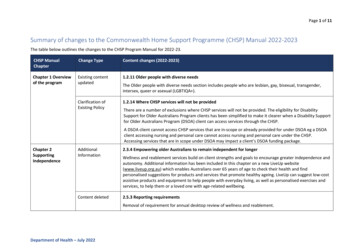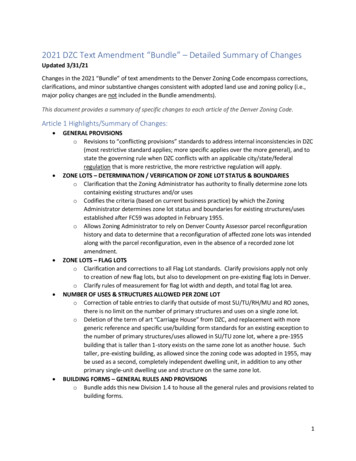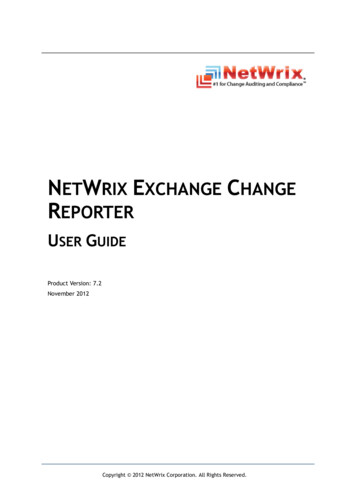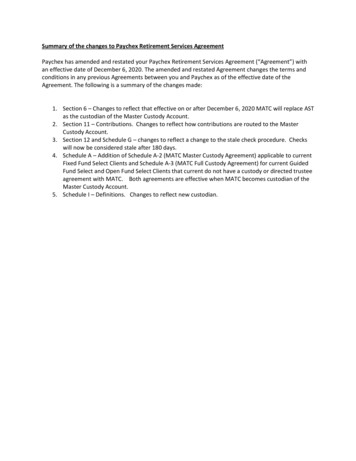
Transcription
Page 1 of 11Summary of changes to the Commonwealth Home Support Programme (CHSP) Manual 2022-2023The table below outlines the changes to the CHSP Program Manual for 2022-23.CHSP ManualChapterChange TypeContent changes (2022-2023)Chapter 1 Overviewof the programExisting contentupdated1.2.11 Older people with diverse needsClarification ofExisting PolicyThe Older people with diverse needs section includes people who are lesbian, gay, bisexual, transgender,intersex, queer or asexual (LGBTIQA ).1.2.14 Where CHSP services will not be providedThere are a number of exclusions where CHSP services will not be provided. The eligibility for DisabilitySupport for Older Australians Program clients has been simplified to make it clearer when a Disability Supportfor Older Australians Program (DSOA) client can access services through the CHSP.A DSOA client cannot access CHSP services that are in-scope or already provided for under DSOA eg a DSOAclient accessing nursing and personal care cannot access nursing and personal care under the CHSP.Accessing services that are in scope under DSOA may impact a client’s DSOA funding package.Chapter 2SupportingIndependenceAdditionalInformation2.3.4 Empowering older Australians to remain independent for longerContent deleted2.5.3 Reporting requirementsWellness and reablement services build on client strengths and goals to encourage greater independence andautonomy. Additional information has been included in this chapter on a new LiveUp website(www.liveup.org.au) which enables Australians over 65 years of age to check their health and findpersonalised suggestions for products and services that promote healthy ageing. LiveUp can suggest low-costassistive products and equipment to help people with everyday living, as well as personalised exercises andservices, to help them or a loved one with age-related wellbeing.Removal of requirement for annual desktop review of wellness and reablement.Department of Health – July 2022
Page 2 of 11CHSP ManualChapterChange TypeContent changes (2022-2023)Chapter 3 SubPrograms Eligibilityand ServicesPolicy Change – NewContent3.2 2022-23 CHSP National Unit Price RangesThe introduction of new national unit prices will assist CHSP providers transition to payment in arrears andprepare for future in-home aged care reforms. The unit price ranges are broadly in line with historical fundingand in many cases consistent with unit costs of other government funded programs (for standard weekdaydelivery during business hours). These ranges were developed by ACIL Allen consulting after thoroughassessment of unit price information, examining comparable pricing approaches for other programs, andconsidering market implications of funding design.It is important to note these ranges do not include a reasonable client contribution over and above fundingfrom the Australian Government. CHSP service providers should implement their own client contributionpolicy, with a view that clients who can afford to contribute to the cost of their care should do so. A CHSPreasonable client contribution range for each service type is also included. These ranges were also developedthrough the work undertaken by ACIL Allen and have been provided as a guide to assist CHSP providers toimplement or review their client contribution policy.ACH, GEAT and Home Modifications will not have national unit price ranges: ACH advocacy and assessment services will transition to the Care Finder Program from 1 January2023. Hoarding and Squalor will continue to be funded through CHSP. Home Modifications will continue to deliver services based on the cost in dollars and will remaincapped at 10,000 (per client per financial year). GEAT will continue with the output measures of cost in dollars and quantity of items (purchased orloaned), noting the cap of 1,000 applies per client per year. GEAT providers will need to report thehours of Allied Health and Therapy services associated with complex GEAT in DEX.The 2022-23 CHSP national unit price ranges and reasonable client contributions information has beenincluded in this chapter.Policy Change – NewContentDepartment of Health – July 20223.3.1 Community and Home Support Sub-ProgramGoods, Equipment and Assistive Technology (GEAT)
Page 3 of 11CHSP ManualChapterChange TypeContent changes (2022-2023)Assessments for complex GEAT services is being broadened from Occupational Therapists to include otherallied health professionals (ie physiotherapist, podiatrist, speech pathologist etc). This will allow for moretimely access to complex GEAT to assist clients to maintain their independence at home.AdditionalInformation3.3.1 Community and Home Support Sub-ProgramHome MaintenanceAdditional information has been included on the consideration of seasonal changes and adjustments forgardening (e.g., mowing less often in winter than summer) as long as the client’s safety and accessibility ismaintained. The output measure of Cost has also been included to align with the DEX reporting protocols.Additionalinformation3.3.1 Community and Home Support Sub-ProgramMealsAdditional information has been included on meals prepared in distribution centres (‘meal hubs’) for otherCHSP meals service providers and the associated output measure for meals delivered via a meals distributioncentre.Additionalinformation3.3.1 Community and Home Support Sub-ProgramNursingAdditional information has been included on the inclusion of wound care under Nursing services. Whereclients are receiving non-health CHSP services in conjunction with post-acute services, a reference has beenadded that clients should access appropriate community nursing services following a hospital stay in the firstinstance. After this, support services must be reviewed to determine whether the client’s current needs arebeing met.Clarification ofExisting PolicyDepartment of Health – July 20223.3.1 Community and Home Support Sub-ProgramSpecialised Support Services (SSS)
Page 4 of 11CHSP ManualChapterChange TypeContent changes (2022-2023)SSS refers to specialised or tailored services for older people who are living at home with a particularcondition, such as continence, dementia, hearing or vision impairment. These services help clients, and theircarers and families, to manage these conditions and maximise client independence to enable them to remainliving in their own homes.Some activities under SSS have been realigned to other service types, such as group social supports andsystem navigation, to ensure consistency across this service type.Additionalinformation3.3.1 Community and Home Support Sub-ProgramTransportAdditional information has been included on clients accessing more than one transport referral where theneed is not met by one provider e.g. one referral for a transport provider for week days and one referral for aone-off medical transport or weekend trip which is not provided by the week day provider. Clients shouldcontact My Aged Care for assistance with accessing these referrals.Policy Change – NewContent3.3.3 Community and Home Support Sub-ProgramAssistance with Care and Housing (ACH)ACH services support eligible clients who are homeless or at risk of homelessness, to access appropriate andsustainable housing as well as community care, residential aged care and other support services, specificallytargeted at avoiding homelessness or reducing the impact of homelessness. ACH services link clients to themost appropriate range of housing and care services to meet their immediate and ongoing needs. Servicesub-types include Assessment and Referrals, Advocacy and Hoarding and Squalor.Clients who are eligible to access Assistance with Care and Housing services are also eligible to access otherCHSP services targeted at avoiding homelessness or reducing the impact of homelessness including clientsaged between 50 and 65 (or between 45 and 50 for Aboriginal and Torres Strait Islander people). However, aclient can only access these additional entry level CHSP services if they are targeted at avoiding or reducingthe impact of homelessness and if they are currently receiving or have been a recipient of Assistance withCare and Housing services. All Assistance with Care and Housing clients must be assessed by My Aged CareDepartment of Health – July 2022
Page 5 of 11CHSP ManualChapterChange TypeContent changes (2022-2023)via the assessment services to determine eligibility and need to receive additional CHSP services.From January 2023, ACH navigation services (assessment/referrals and advocacy) will transition to the newCare Finder Program to streamline navigation supports for aged care.Under the new Care Finder Program, Primary Health Networks (PHNs) will establish and maintain a networkof care finders to provide specialist and intensive assistance to help people within the care finder targetpopulation to understand and access aged care and connect with other relevant supports in the community.PHNs will: commission care finder services based on local needs in relation to care finder supportsupport a transition of the Assistance with Care and Housing (ACH) service type (with the exception ofhoarding and squalor services) to the Care Finder Programdevelop, implement and maintain processes to meet data collection and reporting requirementssupport the integration of the care finder network into the local aged care systemsupport continuous improvement of the Care Finder Programidentify and address opportunities to enhance integration between the health, aged care and othersystems at the local level.Hoarding and Squalor will remain in the ACH sub-program for 2022-23. CHSP Hoarding and Squalor servicescan be offered to clients experiencing symptoms of Hoarding Disorder or who are living in severe domesticsqualor. The range of Hoarding and Squalor services may include developing a client plan, one-off clean-ups,review care plans and linking clients to specialist support services.Information has been included on the new Care Finder Program (from 1 January 2023).Department of Health – July 2022
Page 6 of 11CHSP ManualChapterChange TypeContent changes (2022-2023)Policy Change – NewContent3.3.4 Community and Home Support Sub-ProgramSector Support and Development (SSD)SSD funding has supported the development of the home support service system to enable providers tooperate efficiently and within the context of the broader aged care system.Following a series of reviews and consultation with the sector, SSD funding is being refocussed to supportactivities associated with future in-home aged care reforms. This includes business transformation,supporting reform engagement, education and active participation in an online Community of Practice. SSDproviders will need to allocate at least 75 per cent of their funding towards delivering these new SSDactivities, with remaining funding available to support other activities, such as supporting the volunteerworkforce and mainstream navigation services.Chapter 4 Accessand InteractionsAdditionalInformationClarification ofExisting Policy4.4.1 Aged care assessmentsAdditional information about availability of the new face-to-face Services Australia aged care services hasbeen added. In person supports are now available at dedicated Services Australia service centres.Appointments can be made with an Aged Care Specialist Officer (where one is available) at a ServicesAustralia service centre.4.1.1 Interaction with specific programs and servicesHome Care PackagesThe interaction between Home Care packages and the CHSP section has been clarified and updated. Theclient contribution must be paid for privately and not from the client’s package funds. The short-term or timelimited CHSP services are not defined as this will vary on a case by case basis and will depend on the specificcircumstances and needs of each individual client. However, it is anticipated that up to three months wouldbe considered as short-term services. It is expected that some additional CHSP services might be delivered fora longer period where specific circumstances warrant it. The ACAT is responsible for assessment of a client’seligibility for services under the Aged Care Act, including HCP. If an ACAT issues CHSP referrals for a HCPrecipient, the ACAT is responsible for scheduling suitable Support Plan Reviews to review aged care needs.Department of Health – July 2022
Page 7 of 11CHSP ManualChapterChange TypeContent changes (2022-2023)CHSP service providers also have a responsibility to regularly review a client’s progress against their individualgoals and should refer the client to their most recent assessment service for a support plan review or reassessment if their needs change.Interim CHSP services for clients on the HCP waitlistThe interim CHSP services for clients on the HCP waitlist has been clarified and updated. Where a new clienthas been assessed and approved as eligible for a HCP but is waiting to receive that package, the Aged CareAssessment Team (ACAT) may approve the client for services under the CHSP as an interim arrangement. Theservices will be delivered as entry-level supports consistent with the CHSP not the level of support of thehome care package they are eligible for. The number of CHSP services provided at an entry level will vary on acase by case basis and will depend on the specific needs and circumstances of each client. HCP clients willneed to contribute to the cost of the CHSP as per the CHSP client contribution arrangements and pay forthese fees privately (not from their package funds).Disability Support for Older AustraliansThe section on DSOA has been clarified and updated.DSOA clients are eligible to receive CHSP services that are not provided through DSOA. If a DSOA client wishesto access CHSP services, they should engage My Aged Care in order to undertake an assessment to determinewhether they are eligible for support. In doing so, DSOA clients should clearly outline to My Aged Care theyare a DSOA client, otherwise they may be found eligible for services that are provided through DSOA. In theevent the DSOA client accepts supports under CHSP that are delivered through DSOA, it will be taken that theclient has chosen to exit DSOA.Further information on the DSOA Program and what CHSP services DSOA clients can access is available in theDisability Support for Older Australians Program Manual.Policy Change – NewContentDepartment of Health – July 20224.1.1 Care Finder Program (from 1 January 2023)Primary Health Networks (PHNs) will establish and maintain a network of care finders to provide specialistand intensive assistance to help people within the care finder target population to understand and accessaged care and connect with other relevant supports in the community. PHNs will:
Page 8 of 11CHSP ManualChapterChange TypeContent changes (2022-2023) commission care finder services based on local needs in relation to care finder supportsupport a transition of the Assistance with Care and Housing (ACH) service type (with the exception ofhoarding and squalor services) to the Care Finder Programdevelop, implement and maintain processes to meet data collection and reporting requirementssupport the integration of the care finder network into the local aged care systemsupport continuous improvement of the Care Finder Programidentify and address opportunities to enhance integration between the health, aged care and othersystems at the local level.From January 2023, ACH navigation services (assessment/referrals and advocacy) will transition from theCHSP to the new Care Finder Program. This will streamline navigation supports for aged care. Hoarding andSqualor will remain as part of the CHSP and will be funded for the full 2022-23 financial year.Clarification ofExisting Policy4.1.2 Transition Arrangements for Existing ClientsAdditionalInformation4.4.1 Access to Emergency CHSP servicesThis section has been clarified. Existing clients that were transitioned into the CHSP also included some clientswho would not otherwise be eligible for the program (due to their age and/or level of support required).These clients have been grandfathered into the CHSP and will be supported to transfer to more appropriateservices (such as the NDIS or HCP Program) where appropriate. Service providers should work with My AgedCare and the client when their needs change to transition them to more appropriate services, where possible.Additional information has been included. The circumstances in which there is an urgent need for services tostart immediately will vary. Providers and the contact centre will need to make judgments on a case by casebasis. For example, a client may urgently need immediate services because a carer is no longer available orthere has been a sudden and dramatic loss of a client’s functional ability which, if not addressed immediately,will place the client at risk.It is acknowledged that a number of other services including home maintenance, home modifications, goods,equipment and assistive technology and domestic assistance may be sought urgently. However, it is less likelyDepartment of Health – July 2022
Page 9 of 11CHSP ManualChapterChange TypeContent changes (2022-2023)that a client’s safety would be at risk if these services are not provided immediately, in advance of a holisticassessment by the RAS and an Occupational Therapist (where appropriate).Chapter 5 6 CHSP reasonable client contributionsA CHSP reasonable client contribution range for each service type is included alongside the CHSP national unitprice ranges. These ranges were developed through the work undertaken by ACIL Allen and have beenprovided as a guide to assist CHSP providers to implement or review their client contribution policy.The National Guide to the CHSP Client Contribution Framework has also been updated (June 2022).Chapter 6 Serviceprovider on6.1 Service provider responsibilitiesContent deleted6.1.2 Client rights and responsibilitiesCHSP providers can refer to the CHSP My Aged Care Provider Journey infographic on the Department ofHealth website for further information.Requirement for existing CHSP clients to have a copy of the Aged Care Charter signed by 30 September 2019removed as information out of date.Additionalinformation6.1.4 Staffing and training – First Aid TrainingAdditional information has been included. CHSP providers can use their existing CHSP grant funding, includingunspent funds, to cover the cost of staff and volunteers attending first aid training and refresher courses,where applicable.Where appropriate, CHSP providers may consider the option of online first aid courses to enable staff orvolunteers to complete the training where it is difficult to attend a face-to-face course.Existing contentupdatedDepartment of Health – July 20226.1.8 Service continuityLinks have been included in this section to existing fact sheets on how to provide service delivery in the eventof an emergency or during a heatwave
Page 10 of 11CHSP ManualChapterChange TypeContent changes (2022-2023)Additionalinformation6.1.8 Transition outExisting contentupdated6.1.8 CHSP ad hoc grant opportunityAdditional information included on the requirement for providers to detail any current issues that may impactthe client transition.This section on ad hoc grant opportunities has been updated. The Department recognises the operatingenvironment and demand for services may change during the term of the 2022-2023 CHSP grant agreement.To support CHSP service providers to respond flexibly to local changes, CHSP providers may be able to accessadditional funding through ad hoc grant opportunities. CHSP providers can access information about how andwhen to apply and any application forms on Grant Connect.Additionalinformation6.1.9 Acknowledging the fundingPolicy Change – NewContent6.2.1 Payment in arrearsPolicy Change – NewContent6.3.1 New monthly performance reporting via Data ExchangeCHSP providers should not use the Commonwealth Coat of Arms in their internal advertising and promotionof CHSP services.Information included on payment in arrears arrangements.With the introduction of payment of arrears, new information about provider funding and reporting has beenincluded.From 1 July 2022 all CHSP providers, excluding providers who only deliver SSD, are required to submitmonthly performance reports through Data Exchange. This is a change from six monthly reporting. Monthlyperformance reports will be due on the 14th day of each month (or next business day), commencing from14 August 2022.The submission of a monthly performance Data Exchange report will be mandatory and may be linked to therelease of a provider’s next monthly payment. A provider can choose to submit a report more frequently,Department of Health – July 2022
Page 11 of 11CHSP ManualChapterChange TypeContent changes (2022-2023)such as each fortnight, however at a minimum a report must be submitted monthly within the timeframesprovided below. CHSP providers only delivering SSD will remain on a six-monthly Data Exchange reportingschedule.The Key Reports table has been updated.Clarification ofExisting Policy6.3.3 Managing Performance - Flexibility provisions for ACH and SSD providersNew information has been added on the flexibility provisions under ACH and SSD as the Department of Healthhas implemented additional criteria around the flexibility provisions in relation to this service type.The 100 per cent flexibility provisions enable providers to meet changes in the demand for services betweenfunded service types and Aged Care Planning Regions. Due to the changes in these service types, ACH and SSDproviders cannot reallocate their funding to other service types or outside a funded ACPR without priorapproval from the Department of Health.Content deletedImproving CHSP program assuranceThe content on Improving CHSP program assurance in 2020-21 and the development of a program frameworkhas been removed.Content deleted6.3.4 Embedding a wellness and reablement approach – reportingThe content on the annual desktop review of a random sample of providers has been removed.Appendix C – StateFAMs CHSP ContactsExisting nInclusion of Care Finders Program and edits to Sector Support and Development descriptionThe contact email address for the Northern Territory office has been updated to:NTPerformanceHealth@communitygrants.gov.auNB: Website links in the Manual have been checked and updated where needed.Department of Health – July 2022
Additional information has been included on clients accessing more than one transport referral where the need is not met by one provider e.g. one referral for a transport provider for week days and one referral for a one-off medical transport or weekend trip which is not provided by the week day provider. Clients should











